Typical values at TA = +25°C, ADC
Sampling Rate = 2949.12GHz. Default conditions: output sample rate = 491.52MSPS
(decimate by 6), PLL clock mode with fREF = 491.52MHz, AIN =
–3dBFS, DSA setting = 4dB.
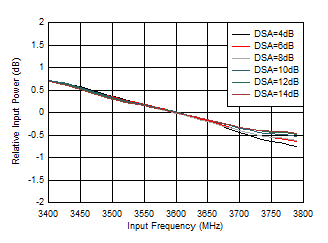
| With 3.6GHz matching, normalized to
3.6GHz |
|
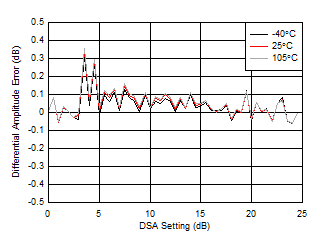
| With 3.6GHz matching |
| Differential Amplitude Error = PIN(DSA Setting – 1) – PIN(DSA Setting) + 1 |
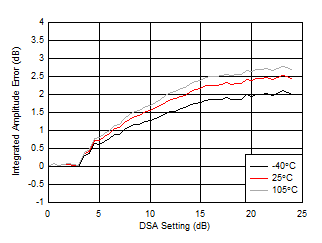
| With 3.6GHz matching |
| Integrated Amplitude Error = PIN(DSA Setting) – PIN(DSA Setting = 0) + (DSA Setting) |
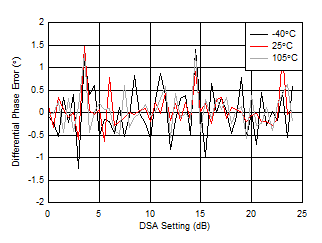
| With 3.6GHz matching |
| Differential Phase Error = PhaseIN(DSA Setting – 1) – PhaseIN(DSA Setting) |
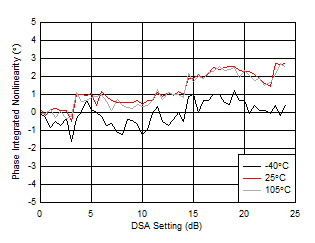
| With 3.6GHz matching |
| Integrated Phase Error = Phase(DSA Setting) – Phase(DSA Setting = 0) |
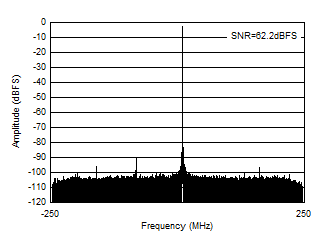
| With 3.6GHz matching , fIN =
3610MHz, AIN = –3dBFS |
|
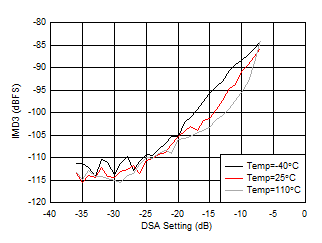
| With 3.5GHz matching, 20MHz tone
spacing |
|
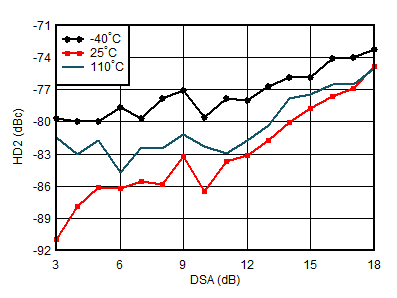
| With 3.5GHz matching, DDC bypass mode (TI only
mode for characterization) |
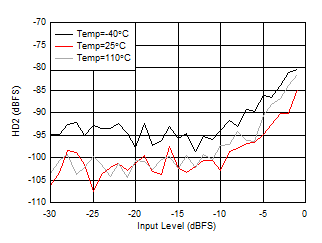
| With 3.5GHz matching, DDC bypass mode (TI only
mode for characterization) |
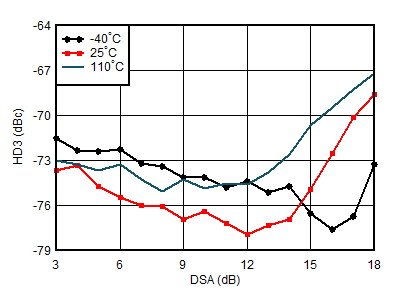
| With 3.5GHz matching, DDC bypass mode (TI only
mode for characterization) |
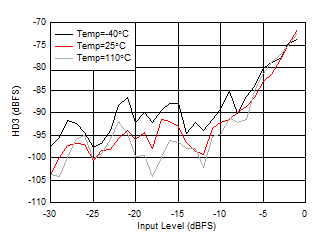
| With 3.5GHz matching, DDC bypass mode (TI only
mode for characterization) |
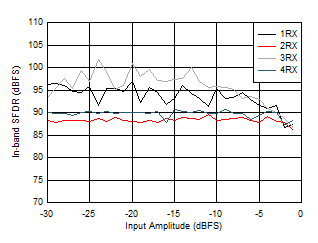 Figure 4-388 RX In-Band SFDR (±200MHz)
vs Input Level and Channel at 3.6GHz
Figure 4-388 RX In-Band SFDR (±200MHz)
vs Input Level and Channel at 3.6GHz
| With
3.6GHz matching, –7dBFS each tone, 20MHz tone spacing,
all supplies at MIN, TYP, or MAX recommended operating
voltages |
Figure 4-390 RX
IMD3 vs Supply Voltage and Channel at 3.6GHz
| With
3.6GHz matching, tone at 20 dBFS, 12.5MHz offset
frequency, all supplies at MIN, TYP, or MAX recommended
operating voltages |
Figure 4-392 RX
Noise Spectral Density vs Supply Voltage and Channel at 3.6GHz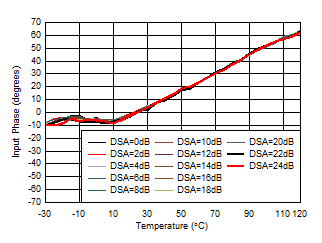
| With 3.6GHz matching, normalized to phase at
25°C |
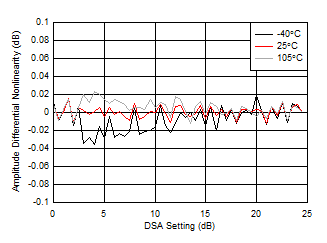
| With 3.6GHz matching |
| Differential Amplitude Error = PIN(DSA Setting – 1) – PIN(DSA Setting) + 1 |
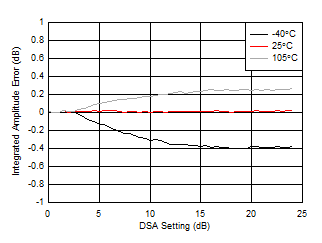
| With 3.6GHz matching |
| Integrated Amplitude Error = PIN(DSA Setting) – PIN(DSA Setting = 0) + (DSA Setting) |
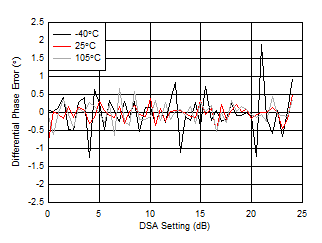
| With 3.6GHz matching |
| Differential Phase Error = PhaseIN(DSA Setting – 1) – PhaseIN(DSA Setting) |
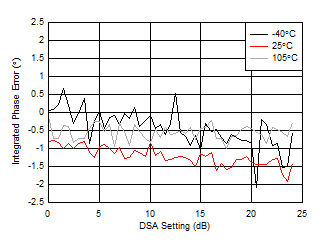
| With 3.6GHz matching |
| Integrated Phase Error = Phase(DSA Setting) – Phase(DSA Setting = 0) |
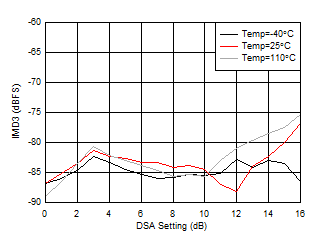
| With 3.5 GHz matching, each tone at –7dBFS,
20MHz tone spacing |
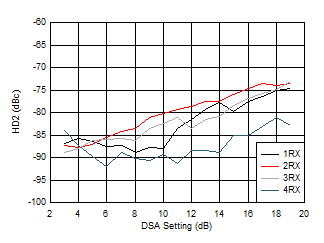
| With 3.5GHz matching, DDC bypass mode (TI only
mode for characterization) |
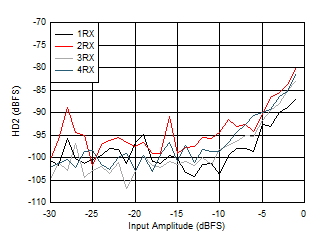
| With 3.5GHz matching, DDC bypass mode (TI only
mode for characterization) |
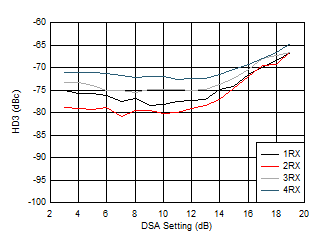
| With 3.5GHz matching, DDC bypass mode (TI only
mode for characterization) |
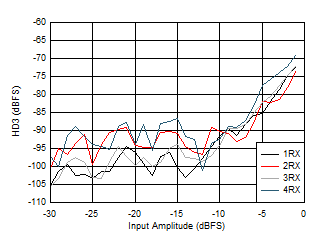
| With 3.5GHz matching, DDC bypass mode (TI only
mode for characterization) |
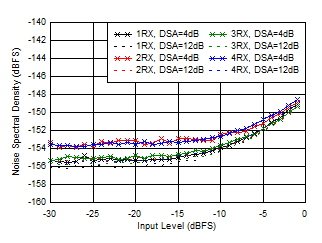
| With 3.5GHz matching, 12.5-MHz offset from
tone |
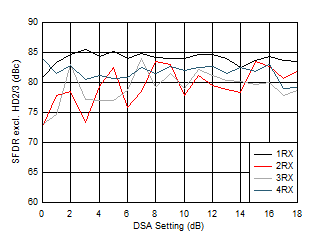 Figure 4-389 RX SFDR Excluding HD2/3
vs DSA Setting and Channel at 3.6GHz
Figure 4-389 RX SFDR Excluding HD2/3
vs DSA Setting and Channel at 3.6GHz
| With
3.6GHz matching, –7dBFS each tone, 20-MHz tone spacing,
all supplies at MIN, TYP, or MAX recommended operating
voltages |
Figure 4-391 RX
IMD5 vs Supply Voltage and Channel at 3.6GHz

























